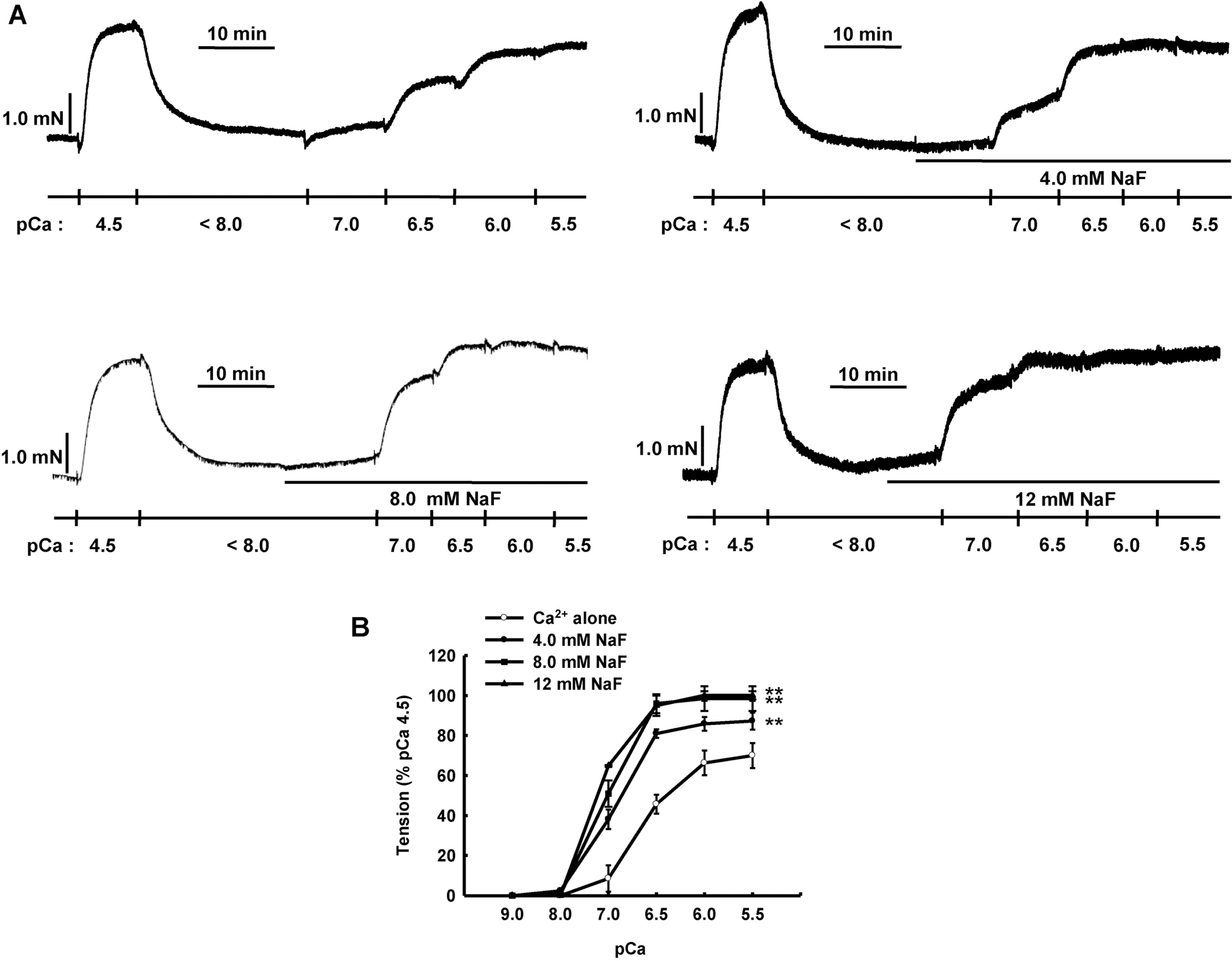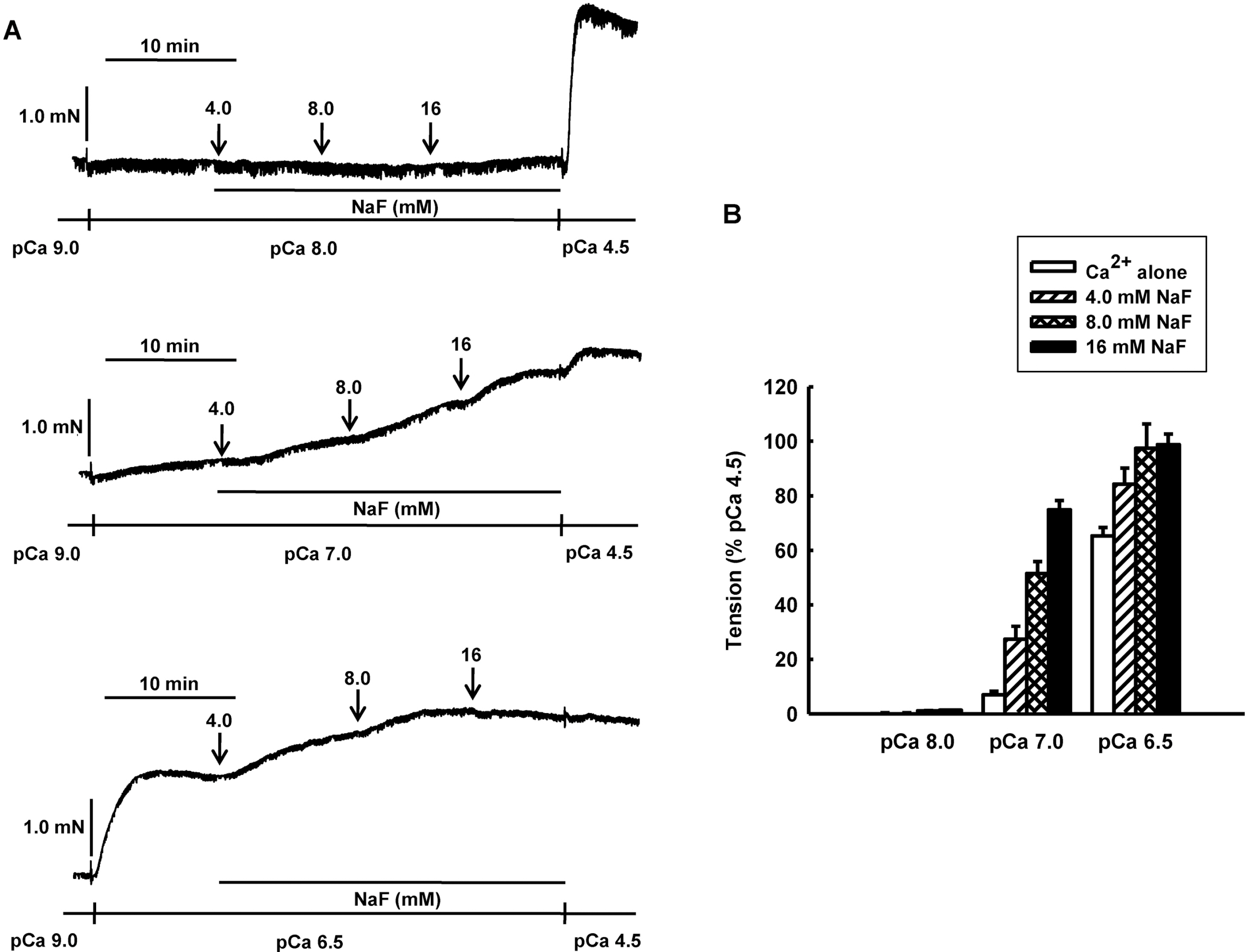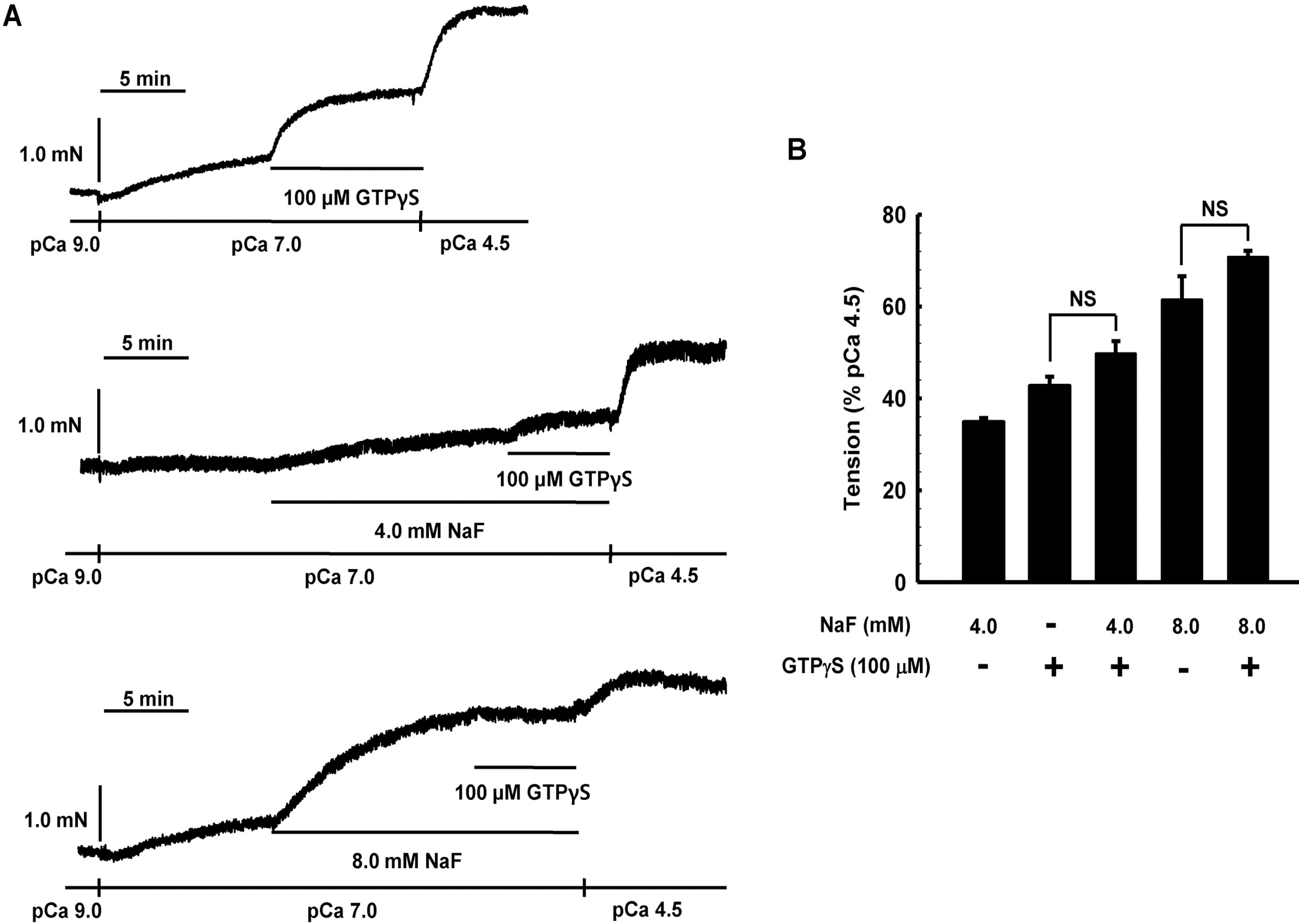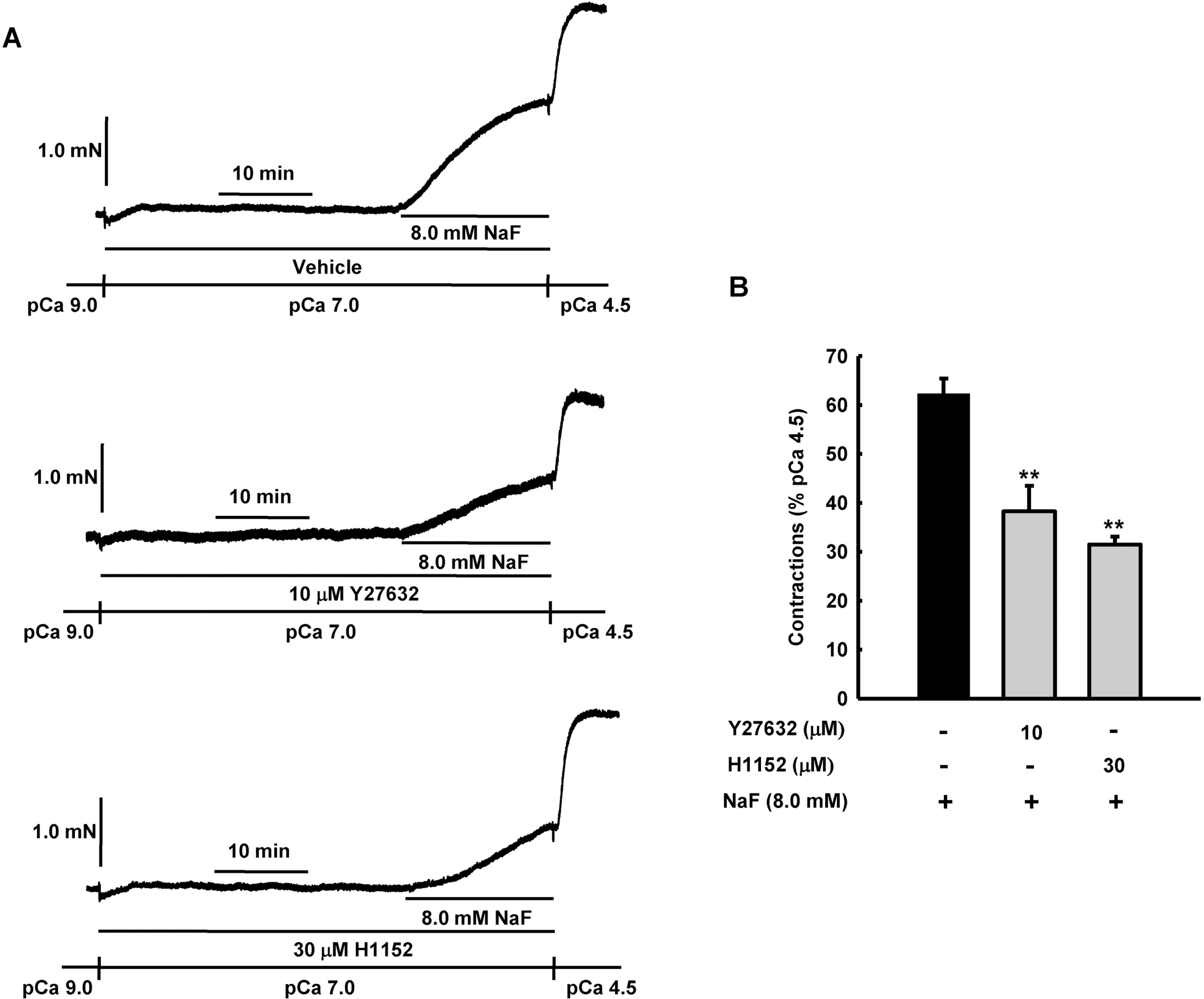Korean J Physiol Pharmacol.
2010 Feb;14(1):51-57. 10.4196/kjpp.2010.14.1.51.
Calcium Sensitization Induced by Sodium Fluoride in Permeabilized Rat Mesenteric Arteries
- Affiliations
-
- 1Department of Pharmacology, Kyungpook National University School of Medicine, Daegu 700-422, Korea. inkim@knu.ac.kr
- 2Department of Thoracic and Cardiovascular Surgery, Kyungpook National University School of Medicine, Daegu 700-422, Korea.
- 3Department of Pharmacology, College of Pharmacy, Chung-Ang University, Seoul 156-756, Korea.
- 4Cardiovascular Research Institute, Kyungpook National University School of Medicine, Daegu 700-422, Korea.
- KMID: 1457701
- DOI: http://doi.org/10.4196/kjpp.2010.14.1.51
Abstract
- It was hypothesized that NaF induces calcium sensitization in Ca2+-controlled solution in permeabilized rat mesenteric arteries. Rat mesenteric arteries were permeabilized with beta-escin and subjected to tension measurement. NaF potentiated the concentration-response curves to Ca2+ (decreased EC50 and increased E(max)). Cumulative addition of NaF (4.0, 8.0 and 16 mM) also increased vascular tension in Ca2+-controlled solution at pCa 7.0 or pCa 6.5, but not at pCa 8.0. NaF-induced vasocontraction and GTPgammaS-induced vasocontraction were not additive. NaF-induced vasocontraction at pCa 7.0 was inhibited by pretreatment with Rho kinase inhibitors H1152 or Y27632 but not with a MLCK inhibitor ML-7 or a PKC inhibitor Ro31-8220. NaF induces calcium sensitization in a Ca2+-dependent manner in beta-escin-permeabilized rat mesenteric arteries. These results suggest that NaF is an activator of the Rho kinase signaling pathway during vascular contraction.
MeSH Terms
Figure
Reference
-
References
1. Hirano K. Current topics in the regulatory mechanism underlying the Ca2+ sensitization of the contractile apparatus in vascular smooth muscle. J Pharmacol Sci. 2007; 104:109–115.2. Somlyo AP, Somlyo AV. Ca2+ sensitivity of smooth muscle and nonmuscle myosin II: modulated by G proteins, kinases, and myosin phosphatase. Physiol Rev. 2003; 83:1325–1358.3. Budzyn K, Marley PD, Sobey CG. Targeting Rho and Rhokinase in the treatment of cardiovascular disease. Trends Pharmacol Sci. 2006; 27:97–104.
Article4. Murthy KS, Makhlouf GM. Fluoride activates G protein-dependent and -independent pathways in dispersed intestinal smooth muscle cells. Biochem Biophys Res Commun. 1994; 202:1681–1687.5. Bogatcheva NV, Wang P, Birukova AA, Verin AD, Garcia JG. Mechanism of fluoride-induced MAP kinase activation in pulmonary artery endothelial cells. Am J Physiol Lung Cell Mol Physiol. 2006; 290:L1139–1145.
Article6. Fujita A, Takeuchi T, Nakajima H, Nishio H, Hata F. Involvement of heterotrimeric GTP-binding protein and rho protein, but not protein kinase C, in agonist-induced Ca2+ sensitization of skinned muscle of guinea pig vas deferens. J Pharmacol Exp Ther. 1995; 274:555–561.7. Yoshimura H, Jones KA, Perkins WJ, Kai T, Warner DO. Calcium sensitization produced by G protein activation in airway smooth muscle. Am J Physiol Lung Cell Mol Physiol. 2001; 281:L631–638.
Article8. Jeon SB, Jin F, Kim JI, Kim SH, Suk K, Chae SC, Jun JE, Park WH, Kim IK. A role for Rho kinase in vascular contraction evoked by sodium fluoride. Biochem Biophys Res Commun. 2006; 343:27–33.
Article9. Yang E, Jeon SB, Baek I, Chen ZA, Jin Z, Kim IK. 17beta-estradiol attenuates vascular contraction through inhibition of RhoA/Rho kinase pathway. Naunyn Schmiedebergs Arch Pharmacol. 2009; 380:35–44.10. Todoroki-Ikeda N, Mizukami Y, Mogami K, Kusuda T, Yamamoto K, Miyake T, Sato M, Suzuki S, Yamagata H, Hokazono Y, Kobayashi S. Sphingosylphosphorylcholine induces Ca2+-sensitization of vascular smooth muscle contraction: possible involvement of rho-kinase. FEBS Lett. 2000; 482:85–90.11. Ryu SK, Ahn DS, Cho YE, Choi SK, Kim YH, Morgan KG, Lee YH. Augmented sphingosylphosphorylcholine-induced Ca2+-sensitization of mesenteric artery contraction in spontaneously hypertensive rat. Naunyn Schmiedebergs Arch Pharmacol. 2006; 373:30–36.12. Choi SK, Ahn DS, Lee YH. Comparison of contractile mechanisms of sphingosylphosphorylcholine and sphingosine-1-phosphate in rabbit coronary artery. Cardiovasc Res. 2009; 82:324–332.
Article13. Durlu-Kandilci NT, Brading AF. Involvement of Rho kinase and protein kinase C in carbachol-induced calcium sensitization in beta-escin skinned rat and guinea-pig bladders. Br J Pharmacol. 2006; 148:376–384.14. Niiro N, Koga Y, Ikebe M. Agonist-induced changes in the phosphorylation of the myosin-binding subunit of myosin light chain phosphatase and CPI17, two regulatory factors of myosin light chain phosphatase, in smooth muscle. Biochem J. 2003; 369:117–128.15. Chiba Y, Takeyama H, Sakai H, Misawa M. Effects of Y-27632 on acetylcholine-induced contraction of intact and permeabilized intrapulmonary bronchial smooth muscles in rats. Eur J Pharmacol. 2001; 427:77–82.
Article16. Johnson RP, El-Yazbi AF, Takeya K, Walsh EJ, Walsh MP, Cole WC. Ca2+ sensitization via phosphorylation of myosin phosphatase targeting subunit at threonine-855 by Rho kinase contributes to the arterial myogenic response. J Physiol. 2009; 587:2537–2553.17. Otto B, Steusloff A, Just I, Aktories K, Pfitzer G. Role of Rho proteins in carbachol-induced contractions in intact and permeabilized guinea-pig intestinal smooth muscle. J Physiol. 1996; 496:317–329.
Article18. Gong MC, Iizuka K, Nixon G, Browne JP, Hall A, Eccleston JF, Sugai M, Kobayashi S, Somlyo AV, Somlyo AP. Role of guanine nucleotide-binding proteins–ras-family or trimeric proteins or both–in Ca2+ sensitization of smooth muscle. Proc Natl Acad Sci U S A. 1996; 93:1340–1345.19. Wilson DP, Susnjar M, Kiss E, Sutherland C, Walsh MP. Thromboxane A2-induced contraction of rat caudal arterial smooth muscle involves activation of Ca2+ entry and Ca2+ sensitization: Rho-associated kinase-mediated phosphorylation of MYPT1 at Thr-855, but not Thr-697. Biochem J. 2005; 389:763–774.20. Kitazawa T, Takizawa N, Ikebe M, Eto M. Reconstitution of protein kinase C-induced contractile Ca2+ sensitization in triton X-100-demembranated rabbit arterial smooth muscle. J Physiol. 1999; 520:139–152.21. Kobayashi S, Somlyo AP, Somlyo AV. Guanine nucleotide- and inositol 1,4,5-trisphosphate-induced calcium release in rabbit main pulmonary artery. J Physiol. 1988; 403:601–619.
Article22. Antonny B, Sukumar M, Bigay J, Chabre M, Higashijima T. The mechanism of aluminum-independent G-protein activation by fluoride and magnesium. 31P NMR spectroscopy and fluorescence kinetic studies. J Biol Chem. 1993; 268:2393–2402.
Article23. Blackmore PF, Exton JH. Studies on the hepatic calcium-mobilizing activity of aluminum fluoride and glucagon. Modulation by cAMP and phorbol myristate acetate. J Biol Chem. 1986; 261:11056–11063.
Article24. Cockcroft S, Taylor JA. Fluoroaluminates mimic guanosine 5′-[gammathio]triphosphate in activating the polyphosphoinositide phosphodiesterase of hepatocyte membranes. Role for the guanine nucleotide regulatory protein Gp in signal transduction. Biochem J. 1987; 241:409–414.25. Gilman AG. Guanine nucleotide-binding regulatory proteins and dual control of adenylate cyclase. J Clin Invest. 1984; 73:1–4.
Article26. Kanaho Y, Moss J, Vaughan M. Mechanism of inhibition of transducin GTPase activity by fluoride and aluminum. J Biol Chem. 1985; 260:11493–11497.
Article27. Bigay J, Deterre P, Pfister C, Chabre M. Fluoroaluminates activate transducin-GDP by mimicking the gamma-phosphate of GTP in its binding site. FEBS Lett. 1985; 191:181–185.28. Uehata M, Ishizaki T, Satoh H, Ono T, Kawahara T, Morishita T, Tamakawa H, Yamagami K, Inui J, Maekawa M, Narumiya S. Calcium sensitization of smooth muscle mediated by a Rho-associated protein kinase in hypertension. Nature. 1997; 389:990–994.
Article29. Wirth A, Benyo Z, Lukasova M, Leutgeb B, Wettschureck N, Gorbey S, Orsy P, Horvath B, Maser-Gluth C, Greiner E, Lemmer B, Schütz G, Gutkind JS, Offermanns S. G12-G13-LARG-mediated signaling in vascular smooth muscle is required for salt-induced hypertension. Nat Med. 2008; 14:64–68.
Article30. Lohn M, Plettenburg O, Ivashchenko Y, Kannt A, Hofmeister A, Kadereit D, Schaefer M, Linz W, Kohlmann M, Herbert JM, Janiak P, O'Connor SE, Ruetten H. Pharmacological characterization of SAR407899, a novel rho-kinase inhibitor. Hypertension. 2009; 54:676–683.
- Full Text Links
- Actions
-
Cited
- CITED
-
- Close
- Share
- Similar articles
-
- Acoustic Emission Characteristic Of The Rat Femur After Administration Of Sodium Fluoride
- Expression of type 1?collagen mRNA of osteoblast like(MC3T3-E1) celss to sodium fluoride
- Evaluation of the Remineralization Capacity of Water-based Silver Fluoride
- The Role of Intracellular Ca2+ in Inhibiting Somatostatin-Induced Pancreatic Amylase Release
- The effect of sodium fluoride and sodium orthovanadate on osteoblastic cell line MC3T3-E1 cells







